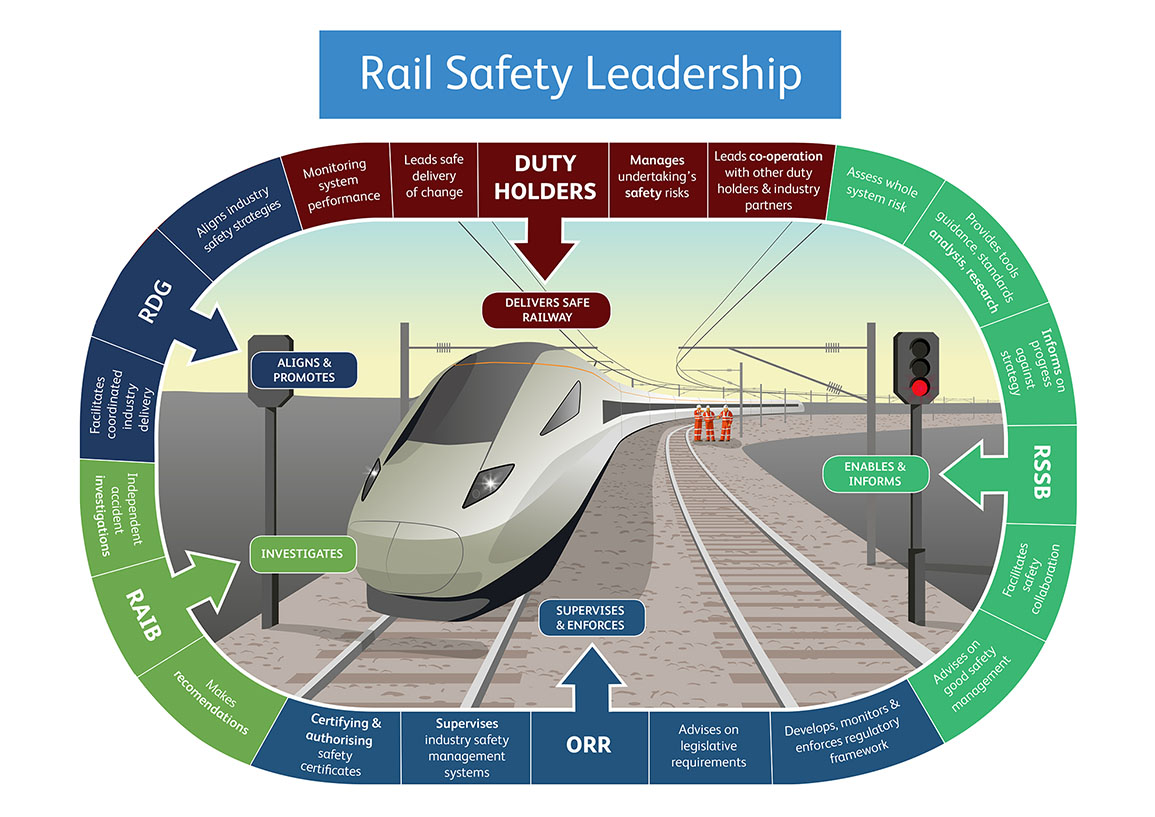Safety on the railway
Committed to a safer railway
Working together, Britain’s rail companies, our people and the entire industry are united in wanting to keep Britain’s railway one of the safest major railways in the world.
Each organisation that operates on the railway has their own specific safety responsibilities which they need to manage. Companies with particular defined safety duties, as written in regulations or standards, are referred to as ‘duty holders’.
Overseeing this are a range of other bodies and organisations which companies will draw on to fulfil the business of operating the railway safely, and combined provide the leadership role on rail safety: Rail Safety and Standards Board (RSSB), Rail Accident Investigation Branch (RAIB) and Office of Rail and Road (ORR).
As part of this, rail companies are absolutely committed to tackling crime and anti-social behaviour on our trains and at stations. Changing the way we work will help to improve safety, ensuring our staff can focus on customers, helping with journey planning, assisting people on and off trains and preventing anti-social behaviour.
Responsibilities
Duty holders
Each company has its own specific safety responsibilities - companies with particular defined safety duties, as written in regulations or standards, are referred to as ‘duty holders’. These are the companies which actually deliver the railway to its customers and hold specific, particular duties on safety. To lead on safety, they have to deliver a safe railway. They also:
- Monitor system performance
- Lead safe delivery of change
- Manage their safety risks
- Lead co-operation with other duty holders and industry partners
Rail Delivery Group (RDG)
RDG is an industry leadership body that works with all the major passenger and freight train operator groups and Network Rail. RDG aligns and coordinates the industry on safety and security.
Rail Partners
Rail Partners is the industry trade body representing the major passenger and freight train operator groups. It aligns and coordinates its members on safety.
RSSB (Rail Safety and Standards Board)
RSSB is a membership-based rail industry body designed to help the railway become safer and more sustainable for passengers, the workforce and the wider public, while reducing risk and cost. It enables and informs safety leadership. It also:
- Management of the industry safety strategy: Leading health and safety on Britain’s railways
- Assesses whole system risk
- Provides tools guidance, standards, analysis, research
- Informs on progress against strategy
- Facilitates safety collaboration
- Advises on good safety management
Rail Accident Investigation Branch (RAIB)
RAIB ensures independent investigation of railway accidents for the purposes of learning and prevention. It makes:
- Independent accident investigations
- Recommendations
Office of Rail and Road (ORR)
One of the ORR’s core functions is health and safety regulation and enforcing authority for the railway. Its role is to make sure that the health and safety of everyone associated with the rail industry is protected. ORR’s contribution to safety leadership is to supervise and enforce. It:
- Certifies and authorises safety certificates
- Supervises industry safety management systems
- Advises on legislative requirements
- Develops, monitors, reinforces regulatory framework
British Transport Police
Rail companies work closely together with the British Transport Police to tackle crime and anti-social behaviour across the entire railway. Over the last ten years, crime on the railway has fallen by a third (34%).
Find out about British Transport Police
Rail safety leadership diagram
For a fuller explanation of who does what on safety leadership, read the RSSB's document Rail safety leadership.
Designing out crime at stations
In January 2024 the British Transport Police, Rail Delivery Group and the Work Related Violence Group published a short document for station managers called Designing Out Crime: Recommendations on how to improve the environment to reduce work-related violence.
The document provides guidance on how to make stations safer for staff and customers. You can read the full document via the link above.
